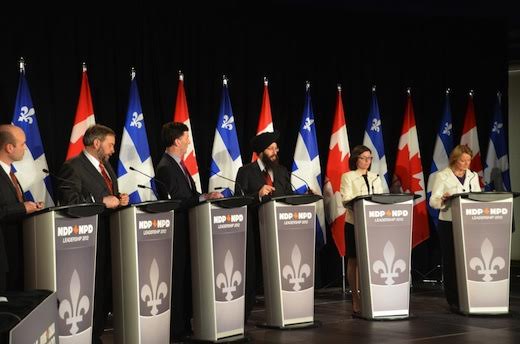
TORONTO – On the same night that Americans were tuning in to find out what the 17 Republican presidential candidates had to offer, north of the border Canadians were watching a debate of their own. The leaders of the country’s four major political parties participated in the first debate of what, by Canadian standards, will be a very long campaign with the potential to make history.
Conservative Prime Minister Stephen Harper requested the dissolution of parliament on Aug. 3, setting the stage for an electoral showdown with the opposition center-left New Democratic Party (NDP) led by Thomas Mulcair on Oct. 19. Rounding out the challengers to Harper are the third-place Liberal Party under Justin Trudeau, and the small but growing Green Party headed by Elizabeth May.
After 10 years of Conservative rule, most polls show the combined anti-Harper vote could top 60 percent. The election comes at a tough time for the Conservatives. With the collapse of oil prices and the decline of the resource-based Canadian dollar, most economists are arguing that the country is already in a recession. The Conservative promise to balance the budget in 2015 looks increasingly impossible and Harper’s economic management is in question. Starting his political career in oil-rich Alberta, the Prime Minister has long remained committed to an unsustainable economic strategy rooted in the exploitation of the oil sands and other resources rather than encouraging development across varied sectors and industries.
Such economic missteps are only the beginning of Harper’s problems. With an ongoing scandal surrounding the illegal use of tax dollars by a number of Harper-appointed senators, an unpopular domestic spying law called Bill C-51, and a heightening of militarism abroad in contrast to past Canadian traditions of peacekeeping, the Conservatives have created many hurdles for themselves.
By calling the election earlier than expected, though, Harper has extended the number of days in the campaign, and therefore the amount of money parties can spend. With his own Conservative Party dominating in the fundraising battle, Harper is betting that his ability to outspend the opposition parties will enable him to drown out their criticisms of his record.
Positioning itself as the home of progressive and center-left voters, the social democratic NDP has presented a platform targeted at a broad majority. Founded in 1961 by a merger between an older socialist party and the trade union movement, the NDP has governed in many provinces but never yet formed a government at the federal level. Under its previous leader, the popular Jack Layton, the party soared into second place in the 2011 election as part of an “Orange Wave,” in reference to the party’s color. In that year, it knocked out the Liberals as the official opposition and decimated the Quebec sovereignist party, the Bloc Quebecois, winning over 100 seats. Layton unfortunately died shortly after, causing some to question whether the NDP’s rise to prominence would stall with the loss of its leader.
Today the party is led by Mulcair, a former Liberal environment minister from Quebec, who has gone toe-to-toe with Harper in parliament on all the contentious issues. Most opinion polls put the NDP in first place, suggesting that the Orange Wave may once again wash over Canada.
The party platform includes a pledge to fund affordable $15-a-day childcare for parents, a $15/hr minimum wage for federally-regulated workers, investments in innovation and technology to promote next-generation manufacturing jobs, tax credits for small and medium sized businesses that create jobs, stronger emissions regulations, and increased investments to repair and expand infrastructure.
The NDP platform is proving popular with many voters and activists. The trade unions and most social movements see the possibility of an NDP victory as the greatest opportunity for progressive advance in decades. In Quebec, the trade union federation announced this week that is was dropping its long-standing support for the Bloc Quebecois party and joining with other unions across the country in backing the NDP. And in one riding (electoral district), 8 of the 10 members on the executive board of the local Liberal Party association have ripped up their party cards and joined the NDP.
With a social democratic government, the political dynamic in the country would certainly shift. Though there are signs pointing to that outcome, it is still a long way to Election Day. Dissatisfaction with Harper runs high, but it remains a tight race.
The goal of unseating Harper is also complicated by divisions on the center-left. The NDP, Liberals, and the smaller Green Party often compete for the same supporters in many ridings, thus splitting the anti-Harper vote. Since the attempt to overthrow Harper in 2008 by means of a Liberal-NDP coalition failed, there have been many “unite the left” proposals put forward, but no official rapprochement between the opposition parties has been forthcoming. Mulcair has expressed his openness to working with the Liberals, but Trudeau has so far refused. Whether the outcome of the current campaign will change the political calculations of the center-left parties remains to be seen.
For now, the NDP is pushing forward with its program to reverse ten years of Harper Conservatism and set Canada on a different path. As the party seeks to make history and inaugurate the country’s first social democratic government, the words of its late leader Jack Layton have become a watchword of the campaign: “Don’t let them tell you it can’t be done.”
Photo: NDP leadership candidates debate on March 4, 2012 in Montreal. (Jonathan Allard/CC/Wikipedia)










